Shortly after publishing my “Tactical Gaming Done Right” article, I received a good number of e-mails urging me to check out certain games that I hadn’t covered. The game that was most heavily cited, time and time again, was an Unreal Tournament mod called “Infiltration” that I had never seriously played before. Wanting to be as thorough as possible, and mindful that I would likely do follow-up articles in the future on this topic, I went ahead and dug out my UT CDs to see what all the fuss was about.
Here we are, a few months later, and I can now clearly see that not having had Infiltration in the original article was a gross oversight on my part. I must plead ignorance for having neglected it. From what I can see now, Infiltration must be considered as the mother of all tactical realism games – or at least the first to implement a vast number of what at the time were brand new concepts. That Infiltration so solidly implements so many features that had never seriously been seen before in the genre is a tribute to the skill and vision of the developers.
It is a shame that the team hasn’t released a version of the mod for a more recent engine than the original Unreal Tournament that it is based off of. If they were able to do so much, so competently with such an old engine so long ago, one can only wonder at what they might pull off with a modern engine.
With all of that being said, I was so impressed by the mod that I decided it was deserving of an entire article of it’s own to highlight some of the more prominent features in it. Many of these features take the crown in their respective categories, and as time allows I will go through the original “Tactical Gaming Done Right” article to cite this when appropriate. Infiltration is most deserving of all the praise it can get.
As I said, this article will be covering many but not all of the noteable features of the Infiltration mod. They’re grouped into two main sections – Weapons & Gear and Movement & Views – but aside from that, they’re in no particular order.
As one last note before we get into things, I would like to clarify in advance that I am not always distinguishing between community addons and the “core” Infiltration experience. Everyone who has contributed towards making Infiltration the game that it is today deserves credit for their part in what I’ve featured below, be they entirely new features and weapons like those seen in the community weapon pack, or maps, or other mutators.
Update, September 25th: PC Gamer UK typo’d and reported this as being a UT2004 mod. It’s not, it’s actually based on the origina Unreal Tournament (which can be found for pennies these days).
Starting off…
To start off this article, I’ve created a video that shows off some of the basic features you’ll find in Infiltration. This is not a comprehensive listing of the many, many fantastic features that Infiltration has, but it does act as a nice primer to the mod.
On to the Basics of Infiltration…
Following that, we’ll kick this off with a combat compilation from the mod.
Next we’ll move on to the meat of the article, where we’ll look at the many outstanding features of Infiltration’s weaponry and gear, followed by the movement and views system.
Infiltration Weaponry & Gear
Ironsights, Ironsight Freeaim, and Recoil
Infiltration, when combined with the Community Weapon Pack, has the best ironsight implementation of any game, ever, and that’s not something I say lightly.
It’s not that the weapon models or textures are the best around – Call of Duty 2, as mentioned in my previous article, is a good example of a game that is really solid on those accounts – but rather that the way they move, the way the player interacts with them, and all the subtle touches that add up to something amazing.


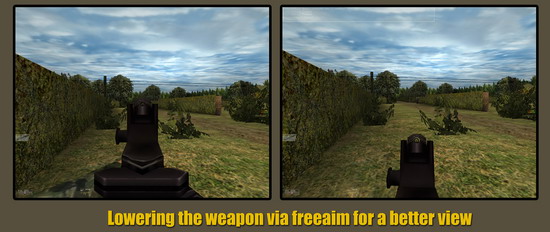

Less subtle is the way the weapon moves when the player is mobile. While at a jog, the weapon moves quite a bit when sighted in and you can clearly tell by the constantly shifting relationship between the front and rear sights (when applicable) that your accuracy on the move isn’t going to be so hot. When walking, on the other hand, the sights can be seen to shift around a bit but one can see that they’ll still be able to fire with decent accuracy.
Last but not least, a player who is crouched and sighted in, upon transitioning to standing, will see his sights disrupt somewhat before going back to normal. This prevents the “Peek up, fire a 100% accurate shot, duck down instantly” behavior that is found in many other games.
Scopes
The scopes in Infiltration are just as solid as their ironsight companions. One pleasant touch is that the field of view for the scopes seems to be far more realistic than what you see in most games. Combine the freeaim system with the parallax modeled and the ability to hold your breath to stabilize your aim and you have a very solid scope system that allows for sharpshooters and snipers to fire at a rate and with an accuracy level that is much more believable than other games. In addition to that, movement while in scoped mode results in your aim point shifting all over the place via the freeaim, making it impossible to fire accurately while on the move with the sniper weapons, just as it should be. It is also impossible to fire a sniper rifle from the hip – you must be in some sort of sighted mode. When it comes to the M-82 SASR, you cannot fire it from any position aside from prone, sighted. This makes sense considering the massive size and bulk of the rifle.


The scopes are actually three parts that can move independantly – two black sheets with a hole in them and one extra part for the reticule. All are 3D models even if they are more or less 2D. The code then lets all three move and wobble around almost like the standard 3D models of a weapon. Due to the ‘holes’ moving and overlapping you get the parallax effect and the reticule moves within.
The following video shows off some scoped sniping.
Sight Options
On many weapons, the player is able to select what kind of sights he wants to use. This is typically the choice between a close-combat optic, iron sights, or a magnified optic. Each has a role and purpose, and each is well-modeled. Infiltration goes beyond that on several of the weapons, allowing for multiple sight systems to be possible on a single weapon. The G-36 is a perfect example of this – the player can toggle between using the small reflex dot optic on the top of the weapon, or the magnified scope below that. You can see this illustrated below.

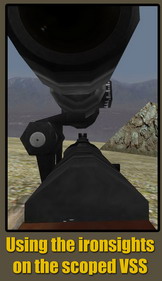
Breath Holding/Stationary Zoom
While in ironsight mode the player’s sights can be seen to subtly shift in relation to each other to a small degree. These minor misalignments do not come into play in close- and medium-range encounters, due to the small amount of misalignment not causing a dramatic impact at such relatively short ranges. However, when shooting at greater distances, the small misalignments are compounded by the distance to potentially cause missed shots, or rounds landing other than where the front-sight tip seems to be pointed.
For an illustration of this phenomenon with both iron-sighted and scoped weapons, here’s a graphic from Army Field Manual 23-10.

Infiltration rolls those three considerations into two functions of the aiming system, and the way that it does it is simple, logical, and intuitively easy to use. Ironsight zoom allows for a stationary player to decrease their field of view so that they can better see their target, while the breath holding feature takes care of the sight alignment and actual breath holding together.
To zoom, one must simply stay still and hold their ironsight key down once they’re in sighted mode – after a brief pause the view will zoom is slightly to allow for better long-range accuracy potential.

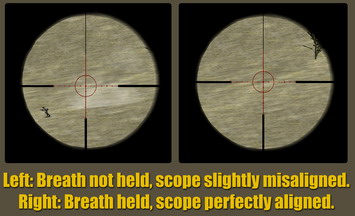
Weapon Configurability & Player Loadouts
Infiltration sports a good number of weapon customization options. You’ll find suppressors, tactical flashlights, laser sights (visible and infrared), close-combat and reflex sights, magnified optics, night scopes, grenade launchers, and some weapons even let you choose between box and drum magazines.
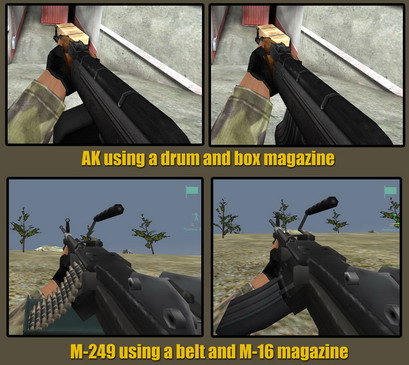
 Infiltration tactical lights actually have a ‘cone’ of illumination, instead of simply being a single point as in some games.
Infiltration tactical lights actually have a ‘cone’ of illumination, instead of simply being a single point as in some games.The M-203, or “Proper M203 sights!”
Amazingly enough, Infiltration actually models the M-203 leaf sight in a realistic, useable fashion. No longer is a player forced to use unrealistic methods to get the 40mm grenades on target – with Infiltration, guess the range, set the sight, and voila! You may not hit them exactly (depending on how accurate your range estimate was), but you’ll be a hell of a lot closer than you’d get with the non-functional systems that other games employ. Now if only more games would get this feature right, we’d be all set (I’m looking at you, America’s Army! Oh, and Flashpoint… and every other game that has ever had an M-203 in it and claims to be realistic).
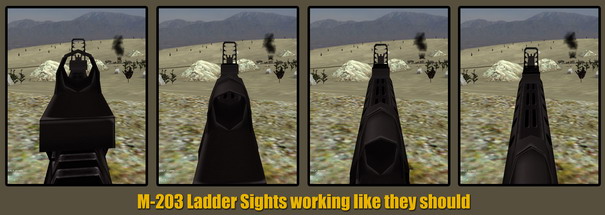

Bullet Penetration & Ricochets
Infiltration has one of the best if not the single best bullet penetration and ricochet models of any tactical game. Penetration varies based on a number of factors, best explained by mod’s Lead Programmer, Norbert ‘Beppo’ Bogenrieder from Aachen, Germany.
We detect the used texture on the surface the bullet hits. Depending on this the possible ricochet angles are determined.
The material and the angle of the impact can increase the chance of allowing a bullet to actually ricochet rather than penetrate.
The distance a bullet is able to ‘travel’ through the object/wall depends on the caliber, the weapon it was fired from, and energy left.
The further a projectile flies before it hits something, the lower its energy potential in form of velocity is, lowering the maximum penetration value a bit, too.
If a projectile is able to penetrate the object or wall it hits then it will continue its flight path on the other side of it. However its damage and penetration potential will be reduced.
This results in the RC.50 being able to fire through several walls in a row, even very thick ones as in reality. Whereas the shot of most pistols is only able to fire through thin walls or doors and the next wall will stop the bullet from penetrating further.
As you can see, the system is quite in-depth, and it’s a refreshing change from the extremely limited penetration seen in games like America’s Army or Raven Shield. The urban environments typically found in Infiltration become all the more interesting when the walls are realistically permeable to bullets. Popping a person while they take cover behind a thin wall, or hosing down an enemy-occupied building from afar are just two of the many different satisfying ways with which you’re likely to find yourself using such a robust model.


The following video shows off a number of bullet penetration and ricochet examples in the mod.
Grenades
Surprise surprise, Infiltration does a fantastic job of modelling hand grenades. Perhaps you’re starting to see the pattern here?
Infiltration combines good aiming, physics, fragmentation modelling, and a solid throwing system to give us one of the best grenade implementations seen thus far.
Starting with the throwing system, players have three options as to how they want to throw. The “High” throw automatically puts the most power into the throw, lobbing the grenade as far as possible. The “Low” throw, on the other hand, is a much “softer” throw that can be used for lobbing grenades a short distance, such as over stone walls. Manual mode allows for the traditional “How long you hold fire dictates how far the throw will be” style. Each has a distinct use in the mod.
For aiming, Infiltration has without a doubt the best aiming method I’ve seen so far. The player’s off-hand is stretched out in a textbook grenade throwing stance, with the tip of his finger indicating where he’s going to throw the grenade. The freeaim system acts as the icing on the cake in this situation, making the overall throwing experience seem more fluid and natural than what you find in games with fixed-aim setups. With the hand as an indication of the intended throw direction, a player is able to achieve great grenade accuracy in a believable, realistic fashion that doesn’t require crosshairs or other artificial indicators as guidance.
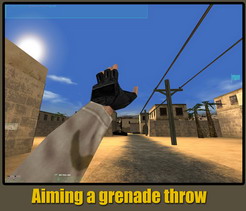
The grenades also have a nice fragmentation system modeled, which results in a fairly good number of individual fragments being flung out from each explosion. These, combined with the blast damage itself, make it a very lethal thing to be standing near a grenade when it goes off. The shrapnel also adds an element of uncertainty to the grenade explosions – you cannot simply be X-many meters away and know that you’ll be unscathed, as there’s always the chance that one or more fragments will rip into you.
The final two nice touches involve the ability to cook a grenade and the way the “spoon” is modeled. You can cook a grenade at any time, giving the enemy less time to react to it once it comes sailing their way. When it comes time to actually throw the grenade, you’ll see the spoon go flying off in mid-air and fall short while the grenade continues on towards its target. As a great touch, if you cook the grenade, the spoon flies off pre-throw – it’s that kind of attention-to-detail, present in all aspects of the mod, that help to make it such a solid experience.
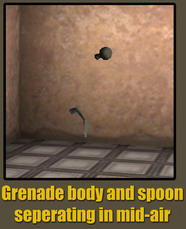
Magcheck
A mutator for Infiltration introduces a system for roughly estimating how many rounds remain in your magazine, since Infiltration – like Red Orchestra – doesn’t give you a magical round count for your magazines. It one-ups the Red Orchestra system, however, since it allows for you to bind a key to “Magcheck”, which will do a quick animation and then give you a rough idea as to how many rounds you have left in the currently-inserted magazine. No longer must you have to put in a fresh mag to ensure that you have rounds remaining. Now, if time permits, you’re able to check the current one to see if you can get by with it or need to do a full reload.
Nightvision
Infiltration has a very solid nightvision system that in many ways is superior to other games’ systems. The basic nightvision goggles are nicely done – they amplify light in a believable manner, flare when you’re firing a weapon, and when switching them off you’re treated to a brief HDR-like moment where the world is darker due to having just taken a relatively bright light source out from in front of your eyes. It’s not bad at all for a mod based off of a game that came out in 1999.
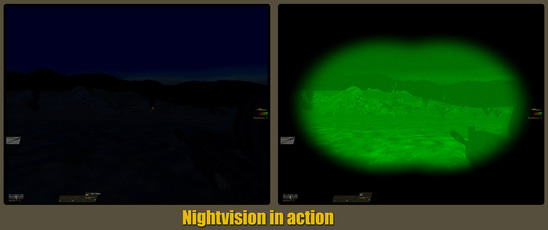

To further help you combat the night, flares are also present in the form of 40mm star parachutes launched from the M-203 grenade launcher. These flares act just like their real-world counterparts, burning bright as they descend slowly beneath a mini-parachute.
Infiltration also manages to do something that, up until now, I didn’t think any game had ever done. It models the AN/PEQ-2 laser aiming module more or less accurately, at least as far as the laser part of it goes. Meaning, the laser projected by the AN/PEQ-2 is in the infrared spectrum, and thus cannot be seen by anyone who isn’t wearing nightvision goggles. This laser designator allows for a person to make accurate aimed shots at close combat ranges while wearing nightvision goggles without having to actually get a sight picture. Infiltration is, as far as I know, the only first-person tactical game that has ever modeled infrared light in such a fashion. It’s a shame that they didn’t also do the infrared combat lights as well, but the IR laser is great regardless.

The XM-29 “Sabre” Objective Individual Combat Weapon (OICW)
The OICW modeled in the Community Weapons Pack for Infiltration is without question the most in-depth and accurate modeling of the weapon that has ever been done in a game. Almost every proposed feature of the weapon has been implemented, to include the laser ranging, ballistic drop compensation, different fuzing options for the 20mm grenade launcher, ammo counter, telescopic adjustable-zoom sight, and nightvision device.
Only in Infiltration can you truly come to appreciate how extraordinary of a weapon the OICW was planned to be. The fuzing options – point-detonating, point-detonating (delayed), window, and air-burst – give an infantryman an unprecedented ability to kill his foes regardless of what measures they take to protect themselves. From air-bursting grenades over the tops of trenches, to having the grenades explode only after passing through the outer wall of the house, or having grenades ricochet off of a surface before exploding in mid-air, the OICW is capable of dealing an extraordinary amount of deadly-accurate damage with each of the six 20mm grenades stored in the removeable magazines. Throw in the ballistic compensation and laser rangefinding and you’re able to deliver those 20mm grenades and 5.56mm bullets with a first-round accuracy unmatched by any other infantry weapon system.
It is a testament to the realism of the mod’s weapon modeling and painstaking attention to detail that the OICW stands out so boldly as the impressive piece of future weapon technology that it is.
In the below picture I’ve marked up the OICW’s HUD to explain what everything on it means. Thanks to the way the special weapon keys are used (ActivateAttachment and WeaponMode, along with the ironsight key), a player is able to switch between the different fuze modes, between the grenade and rifle parts, and zoom in/out with the scope effortlessly.
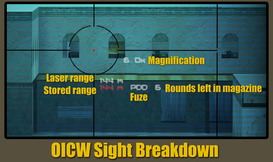
Claymore Anti-Personnel Mines
The most notable feature of Infiltration’s claymore system is the ability for a player to string up tripwires for the mines. Each claymore has four tripwires to work with and each of these wires has a specific maximum length. You can either use up the full length of a wire stretching it out from the mine to its maximum, or you can more intricately have a wire that has multiple segments to better cover an area. Meaning that the player can attach a wire to the mine, then to a wall, then to another wall and so on or even back to the mine itself or another one, until the full length of the wire is exhausted.

The following video illustrates the basics of the claymore usage in Infiltration.
Reloading
Not surprisingly, Infiltration models both tactical and dry reloads. You can see this illustrated with a variety of different weapons in the following video.
The surprising thing is the degree to which the animations have been done. Pick up a 1911, for instance, and you’ll find a perfect example of the typically exceptional attention to detail displayed throughout the mod. If you empty the magazine and have the slide lock back, upon holstering it you’ll see that your character releases the slide before holstering it – just like anyone would do in reality, since you don’t holster a slidelocked pistol. It gets better than that, however – draw the pistol once more and the slide will be forward on an empty chamber and empty magazine. Pull the trigger and the hammer will drop on the empty chamber, after which your character’s thumb will cock it back again. Reload at this point and your character will drop the empty magazine, insert a new one, and then manually pull the slide to the rear before releasing it to chamber a new round. That Infiltration has dedicated animations for something like this, when almost as a rule all other games miss such details, is once again testament to the incredible attention to detail displayed by the team.
Another example can be found with the RC .50cal sniper rifle. The weapon has two firing modes, manual and automatic bolting. In automatic mode the player fires, and when releasing his fire key, the bolt is automatically worked to chamber the next round. In manual mode, the player manually cycles the bolt to chamber a new round. The neat part is that, unlike Red Orchestra, you can actually work the bolt at any time. Thus, you can potentially eject a live round if you aren’t paying attention to what you’re doing.
Armor vests
Infiltration also includes two types of armor vests. The best one can defeat multiple submachinegun or pistol-caliber rounds, while rifle rounds will punch clean through them. The FN 5-7 and FN P-90, due to their armor-piercing capabilities, will go clean through them as well. Kevlar helmets are also included.
Infiltration Movement & Views
Weapon Collision with Environment

This system also makes it so that a player cannot depress or elevate a rifle beyond what would physically be possible given environmental restrictions. For instance, if an opponent is spotted a few meters outside of a building at ground level, and the player is shooting out of a second-story window, he may not be able to depress his weapon past the window sill to shoot the enemy. If so, he might need to raise his posture, get closer to the window, and almost lean out to take the shot. It’s a small thing, but it has significant ramifications on gameplay.
One neat side effect of this system is that a player can actually charge a glass window and break it out with the muzzle of his rifle, without needing to use any special keys to perform a ‘bash’ maneuver.
Weapon Deployment & Mounted Machineguns
Infiltration’s recently-released deployment model builds on the system that was implemented for their excellent .50cal machinegun emplacements. In that, the player’s actual physical body dictates how far the weapon can be traversed. If there is some sort of obstacle – sandbags, for instance – the player can traverse the weapon until he physically is pushed into the barrier. The player pivots around the machinegun, as it should be, and the machinegun emplacement (be it a bunker, sandbags, or what have you) naturally acts as the traversing limits.
The deployment model takes this basic idea and applies it to all weapons. A player can rest his weapon on any surface in the game, much like Red Orchestra’s system, and press a key to ‘deploy’ his weapon. The deployment is instantaneous, and if the player’s movements exceed the limits of the deployment, it will automatically end. This means that a player cannot get ‘locked’ into a deployed state, unable to react swiftly to events. If someone pops up near you while you’re deployed, you need only rapidly turn towards them to ‘break’ the deployment and allow you to engage them.
The deployment system also distinguishes between bipod-equipped weapons when in the prone – a player cannot deploy a submachinegun from the prone, for instance, but he can deploy any weapon with a bipod (Minimi machinegun, M-14 DMR, M-82 SASR). The exception to this is if there is something for a non-bipod-equipped weapon to actually rest upon – a sandbag, ammo crate, etc. Also, if you position yourself on a slope in the right way you’ll be able to use it for support. This comes into play when firing over the peak of a roof, for instance.
The big selling point of the deployment system is that the player pivots around his deployed weapon – something that almost all other games, including Red Orchestra, fail to model. Instead of it being player-centric turning, it instead is weapon-centric deployment with the player pivoting around said deployed weapon. You can see this clearly illustrated in the following video, which also covers the M2 .50cal machinegun emplacements.
Slowed turn speeds when crouched and prone
This one’s pretty simple, and it has a nice impact. When a player is crouched or prone, their turning speed is cut down substantially. It’s a simple thing, and it has a definite positive impact on preventing crouched or prone people from whirling around faster than they reasonably should be able to.
Prone
As is typical of Infiltration, the prone system is well thought out and features a number of elements that make it superior to most other games. A player’s body is well-simulated in it, meaning that they cannot go prone somewhere that they could not physically do so. If you’re walking on a thin ledge, prone is out of the question. Backed into a tight corner? Prone, again, is not possible. Worried about your foot clipping through something when prone and giving you away? Not going to happen – again, Infiltration’s prone system accounts for all of this and prevents the gamey stuff from occuring. You also cannot turn yourself in a certain direction while prone if there’s a wall blocking you from doing so. On top of that, Infiltration also sports two speeds of prone and crouched movement.
Stamina
As mentioned previously, the amount of weaponry and gear that the player is carrying dictates how fast their movement speed is, and how quickly their stamina is drained when sprinting. The mod goes beyond this, however, with what is ultimately a very solid stamina system. This is best explained by Beppo:
Everything ‘extra’ you do causes you to lose more stamina.
For instance, instead of interrupting your weapon reload if you need to get behind cover quickly while doing so, you are allowed to continue the reload giving you an extra stamina penalty. However, you cannot start to reload while you are sprinting, but we do allow you to sprint behind cover while you reload. Otherwise players would play sitting ducks while reloading like they do in other games.
In INF you can still do something, allowing you to even reload in tight situations that can save your live then.
Jogging reduces your stamina slightly. If you aim your weapon while jogging then it decreases a lot faster.
If you jump your stamina gets decreased. The actual jump height depends on your stamina, so if you try to play bunny hopping you will find yourself almost cemented to the floor after only a few jumps.
Your bulk (all the inventory you are carrying affects this) that affects your maximum stamina actually shortens and lowers everything you can do, like sprinting, jumping aso. The weapon bob is affected by your stamina, too. The lower your current stamina is, the more your weapon starts to wobble around. You breath heavier as well.
Out of that, one of my favorite parts concerns how you have very few restrictions on what you do, but there are appropriate penalties for doing ‘stupid’ things like rushing all over the place with your weapon raised the whole time, or trying to jump all over, or reload at a sprint. Since circumstance dictates just how stupid these actions ultimately are, it’s nice to be able to do them, as there are frequently situations in games where you must do something that would normally be against your better judgement in the interest of saving your skin. That Infiltration allows for this is a welcome change from the rigid restrictions found in other games.
Closing
So, there you have it. Infiltration in a very big, well-illustrated nutshell.
While I have covered a great many of the notable features of the mod, this is by no means a comprehensive review of every single solid feature in it. It does, however, cover the most important ones, the ones I hope to see in future games of the genre. If you would like to read more about Infiltration, feel free to check out the official Infiltration site and the official Infiltration forums.
As far as the future of Infiltration itself goes, I hope that we see Sentry Studios show up somewhere down the line to make a successor in a more modern engine. The team certainly knows what it’s doing when it comes to tactical realism, and the thought of having them create a similar mod in a cutting-edge engine like the Unreal Engine 3.0 is quite appealing. If not, perhaps some of the developers in the FPS genre will take a long hard look at what they’ve created and try to integrate some of the innovative features in it into future titles. Here’s hoping, at least.
As always, I’m interested in getting feedback. If you enjoyed this article, have comments on it, or want to suggest something for me to potentially cover in the future, feel free to contact me at my GMail address, which is dslyecxi@gmail.com
If you’re interested in reading anything else I’ve written, go ahead and jump to my Articles page. There’s some good stuff there, if I do say so myself.
Credits
Thanks must go out first to the Infiltration fans who sent me many e-mails after my Tactical Gaming Done Right article was published to let me know about a superb one I had missed.
After that, my thanks go out to Beppo for providing a wealth of excellent feedback on this article during its production, including telling me about a number of features I had missed on my playthroughs. And, of course, he and the Infiltration team – to include the community contributors – deserve a great deal of praise for the superb mod they created.
Thanks also go out to the other people who gave me valuable feedback on the article during its creation.





2 comments
1 ping
I wish I had the chance to play this game. This is everything I’ve ever wanted in a shooter. The closest thing to this now is the game Insurgency, which I’ve been playing non-stop for a few months now. But I would really love for a developer to remake this game on a modern engine. It would certainly have a market, seeing as Insurgency does and features SOME of these things.
Wow, that was impressive! Thanks for the effort and enthusiasm that you put into your Best Of Tactical Gaming articles. It’s astounding how far FPS gaming has come since the UT days and yet it feels like so little effort goes into implementing realistic (and simple) gameplay mechanics that can so powerfully enhance the value of a modern shooter. More developers should be referencing mods like this for inspiration instead of focusing on blockbuster cinematics ala Call of Duty. I can’t wait to break this out at the next LAN.
[…] Once upon a time, a much-younger me wrote an article about tactical gaming. At that time I was an Operation Flashpoint player, grown used to using the game’s “freeaim” system – wherein the weapon was not aligned with the view, and instead moved freely in a box shape. Another game at the time – Red Orchestra – used a similar system, as did a landmark tactical mod called Infiltration. […]